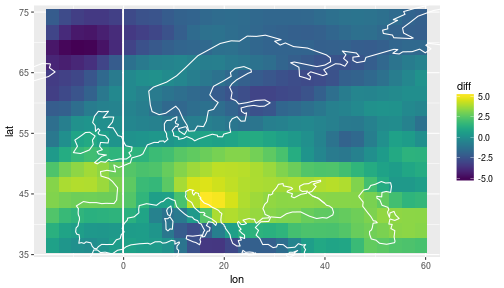Strom track density
Libraries, preliminaries
I will use pipes, tibbles and other goodness from the tidyverse, coastline data from rnaturalearth, the viridis color scheme, and INLA for statistical inference:
suppressPackageStartupMessages(library(tidyverse))
suppressPackageStartupMessages(library(stringr))
suppressPackageStartupMessages(library(viridis))
suppressPackageStartupMessages(library(INLA))
coast = rnaturalearth::ne_coastline(scale=110) %>% fortify %>% as_data_frame
The data
The data we are looking at are spatial fields of storm track density (number of storms that pass through an area per season).
All the data is stored in a “tidy” data frame called storms, the track density variable is called tden:
load('data/storm-track-density.Rdata')
storms %>% print(n=3)
## # A tibble: 4,320 x 5
## lat lon model experiment tden
## <dbl> <dbl> <fctr> <fctr> <dbl>
## 1 36.47029 -14.16104 model_1 historical 4.460165
## 2 38.98548 -14.16104 model_1 historical 7.017774
## 3 41.50068 -14.16104 model_1 historical 10.581059
## # ... with 4,317 more rows
We have data from 4 climate models that have simulated past and future storms. We also have historical observation data. The area we are looking at is (roughly) Europe and the season is winter (DJF). The data looks like this:
ggplot(data=storms) +
geom_tile(mapping=aes(x=lon, y=lat, fill=tden)) +
facet_grid(model ~ experiment) +
scale_fill_viridis() +
coord_cartesian(xlim = range(storms$lon), ylim=range(storms$lat)) +
geom_path(data=coast, aes(x=long, y=lat, group=group), col='white')
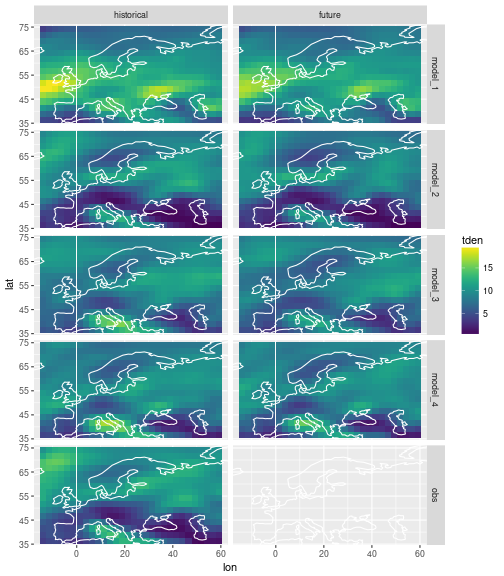
The problem
Changes in storm activity over Europe under climate change is obviously of interest to a range of stakeholders, policy-makers, and the public in general. So we want to use all the above data to say something about the expected future storm track density over the region of interest, as well as the associated uncertainty.
We don’t expect future climate to be much different from past climate, so the historical observations will certainly be informative about future climate. The climate model output includes much of our physical understanding about the climate system, as well as a likely scenario about future greenhouse gas emissions, which have an impact on the physical boundary conditions that drive the climate system. So we will want to consider climate model output as well. The existence of multiple climate models from different research centers, and the fact that they don’t agree on future climate tells something about the imperfections in the models, which we will want to account for.
Our goal is to use all the model data and the observations in a coherent statistical framework to fill in the blank field in the plot above, the one for the future observations, calculating both a best guess estimate as well as the associated uncertainty.
This will involve a fair bit of spatial statistical modelling, for which we will use the R package INLA (the name R-INLA is also used), which implements the Integrated Nested Laplace Approximation methodology.
Smoothing a spatial field with R-INLA
As a preliminary, we will use R-INLA to decompose a single spatial field into a smooth and a random component. Here we will model the spatial correlation of the smooth component by a 2-dimensional random walk, and the random component by independent Gaussian noise.
The 2d random walk is a generalisation of the 1d random walk, where the value $x_{i,j}$ at the gridpoint $(i,j)$ is given by a weighted average of its nearest neighbours plus independent Normal noise with zero mean and precision $\tau$, i.e.
\begin{equation} (x_{i+1,j} + x_{i-1,j} + x_{i,j+1} + x_{x,j-1}) - 4x_{i,j} \sim N(0, \tau^{-1}) \end{equation}
The precision parameter $\tau$ acts as a smoothness parameter. The higher $\tau$, the less will $x_{i,j}$ differ from the average over its neighbors, and thus the smoother will be the 2d field.
In R-INLA, the 2d random walk model is paramtrised differently, using not only 4, but 12 nearest neighbors, with positive and negative weights.
To fix the log-precision at a value of 1 the rw2d model is specified as follows:
nlon = select(storms, lon) %>% unique %>% nrow
nlat = select(storms, lat) %>% unique %>% nrow
logtau = 1
inla_formula = tden ~ 1 +
f(point, model='rw2d', nrow=nlat, ncol=nlon,
hyper=list(theta=list(initial=logtau, fixed=TRUE)))
The 2d random walk model in INLA only applies to data on a rectangular grid.
The 2d field must be saved as a vector in which the columns of the matrix are stacked on top of each other.
Our data frame storms has track density already in this format, since longitudes change fastest and latitudes change slowest as you go down the data frame.
So it is straightforward to create the INLA data frame.
We will only work with the field of historical observations for now.
inla_data = storms %>%
filter(experiment == 'historical', model == 'obs') %>%
select(lon, lat, tden) %>%
mutate(point = 1:(nlon*nlat))
We run INLA with the option control.predictor=list(compute=TRUE) because we want to extract fitted values later:
inla_out = inla(formula=inla_formula, data=inla_data,
control.predictor=list(compute=TRUE, link=1))
df = inla_data %>%
rename(original = tden) %>%
mutate(fitted = inla_out$summary.fitted.values$mean) %>%
gather(key='key', value='tden', original, fitted) %>%
mutate(key = factor(key, levels=c('original', 'fitted')))
ggplot(data=df) +
geom_tile(mapping=aes(x=lon, y=lat, fill=tden)) +
facet_wrap(~ key) +
scale_fill_viridis() +
coord_cartesian(xlim = range(storms$lon), ylim=range(storms$lat)) +
geom_path(data=coast, aes(x=long, y=lat, group=group), col='white')
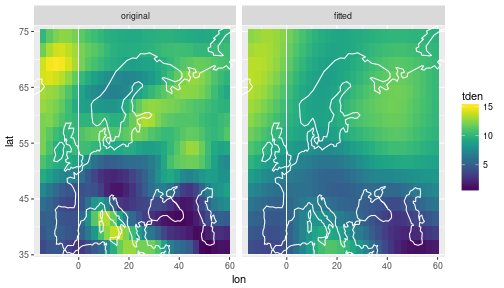
The fitted values are smoother than the original. If we change the precision value of the random walk, we can play with the smoothness:
rw_df = inla_data %>%
select(lon, lat, tden) %>%
mutate(smooth = 'original')
for (logtau in c(0.5,1,3)) {
inla_formula = tden ~ 1 +
f(point, model='rw2d', nrow=nlat, ncol=nlon,
hyper=list(theta=list(initial=logtau, fixed=TRUE)))
inla_out = inla(formula=inla_formula, data=inla_data,
control.predictor=list(compute=TRUE, link=1))
out_df = inla_data %>% select(lon, lat) %>%
mutate(tden = inla_out$summary.fitted.values$mean) %>%
mutate(smooth = str_c('logtau=', logtau))
rw_df = bind_rows(rw_df, out_df)
}
ggplot(data=rw_df) +
geom_tile(mapping=aes(x=lon, y=lat, fill=tden)) +
facet_wrap(~ smooth, nrow=1) +
scale_fill_viridis() +
coord_cartesian(xlim = range(storms$lon), ylim=range(storms$lat)) +
geom_path(data=coast, aes(x=long, y=lat, group=group), col='white')

Decomposing spatial fields into common and individual components
inla_formula = tden ~ -1 +
f(i_rw_common, model='rw2d', nrow=nlat, ncol=nlon) +
f(i_bias, model='iid') +
f(i_rw_indiv, model='rw2d', nrow=nlat, ncol=nlon, replicate=repl)
n = nlon * nlat
m = storms %>% select(model) %>% unique %>% nrow
inla_data = storms %>%
filter(experiment == 'historical') %>%
select(lon, lat, tden) %>%
mutate(i_rw_common = rep(1:n, m)) %>%
mutate(i_bias = rep(1:m, each=n)) %>%
mutate(i_rw_indiv = rep(1:n, m)) %>%
mutate(repl = rep(1:m, each=n))
inla_out = inla(formula=inla_formula, data=inla_data)
lonlat = inla_data %>%
filter(repl == 1) %>%
select(lon, lat)
The common mean
df_common =
bind_cols(
lonlat,
inla_out$summary.random$i_rw_common %>% as_data_frame
) %>%
select(lon, lat, mean)
ggplot(data=df_common) +
geom_tile(mapping=aes(x=lon, y=lat, fill=mean)) +
scale_fill_viridis() +
coord_cartesian(xlim = range(storms$lon), ylim=range(storms$lat)) +
geom_path(data=coast, aes(x=long, y=lat, group=group), col='white') +
labs(fill = NULL)
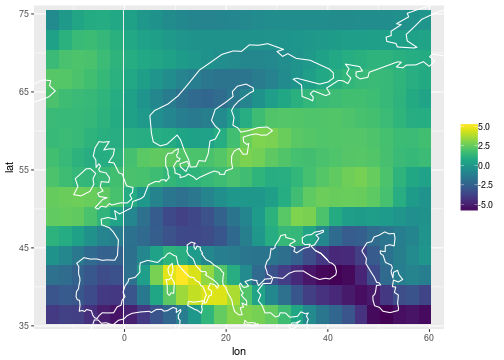
The individual biases
df_bias =
inla_out$summary.random$i_bias %>% as_data_frame %>%
select(ID, mean) %>% # extract ID and mean
mutate(lon=0, lat=0) %>%
rename(repl = ID) %>% mutate(repl = str_c('bias_', repl))
ggplot(data=df_bias) +
geom_tile(aes(x=lon, y=lat, width=180, height=180, fill=mean)) +
scale_fill_viridis() +
facet_wrap(~ repl, nrow=1) +
coord_cartesian(xlim = range(storms$lon), ylim=range(storms$lat)) +
geom_path(data=coast, aes(x=long, y=lat, group=group), col='white')
## Warning: Ignoring unknown aesthetics: width, height

The posterior standard deviation on all the bias terms is very small, order of 0.001.
The individual residuals
df_resid =
inla_out$summary.random$i_rw_indiv %>% as_data_frame %>%
select(ID, mean) %>% # extract ID and mean
group_by(ID) %>% # create groups of 5 for each ID
mutate(repl=str_c('resid_', 1:n())) %>% # add replication index 1:size_of_group
nest %>% # put each group into a data frame
bind_cols(lonlat) %>% # bin lonlat data frame
unnest(data) # expand nested data frames again
ggplot(df_resid) +
geom_tile(aes(x=lon, y=lat, fill=mean)) +
scale_fill_viridis() +
facet_wrap(~ repl, nrow=1) +
coord_cartesian(xlim=range(storms$lon), ylim=range(storms$lat)) +
geom_path(data=coast, aes(x=long, y=lat, group=group), col='white')

Combining past and future
Assumptions, partly based on belief about the physics, partly just to simplify the inference:
- biases persist into the future
- future common mean does not depend on past common mean
- all residuals are realisations of the same random process
nlon = select(storms, lon) %>% unique %>% nrow
nlat = select(storms, lat) %>% unique %>% nrow
n = nlon * nlat
m = storms %>% select(model) %>% unique %>% nrow
inla_formula = tden ~ -1 +
f(i_rw_common, model='rw2d', nrow=nlat, ncol=nlon, replicate=repl_rw_common) +
f(i_bias, model='iid', replicate=repl_bias) +
f(i_rw_indiv, model='rw2d', nrow=nlat, ncol=nlon, replicate=repl_rw_indiv)
inla_data = storms %>%
# add unobserved future observations as NAs
bind_rows(
storms %>%
filter(model == 'obs', experiment == 'historical') %>%
mutate(experiment = factor('future', levels=levels(storms$experiment))) %>%
mutate(tden = NA_real_)
) %>%
# add common mean time and replication indices
group_by(experiment, model) %>% mutate(i_rw_common = 1:n) %>% ungroup %>%
mutate(repl_rw_common = as.integer(experiment)) %>%
# add bias time and replication indices
mutate(i_bias = 1) %>%
group_by(model) %>% do(bind_cols(., repl_bias = as.integer(.$model))) %>% ungroup %>%
# add residuals time and replication index
group_by(experiment, model) %>% mutate(i_rw_indiv = 1:n) %>% ungroup %>%
mutate(repl_rw_indiv = as.integer(as.factor(str_c(model, experiment))))
inla_out = inla(formula=inla_formula, data=inla_data, control.predictor=list(compute=TRUE, link=1))
inds = with(inla_data, which(experiment == 'future' & model == 'obs'))
pred_row_names = str_c('fitted.Predictor.', str_pad(inds, width=4, side='left', pad='0'))
df_pred =
inla_data %>%
filter(experiment == 'future', model == 'obs') %>%
bind_cols(inla_out$summary.fitted.values[pred_row_names, ]) %>%
select(lat, lon, mean, sd) %>%
gather(key='posterior', value='value', mean, sd)
ggplot(df_pred %>% filter(posterior == 'mean')) +
geom_tile(aes(x=lon, y=lat, fill=value)) +
scale_fill_viridis() +
coord_cartesian(xlim=range(storms$lon), ylim=range(storms$lat)) +
geom_path(data=coast, aes(x=long, y=lat, group=group), col='white')
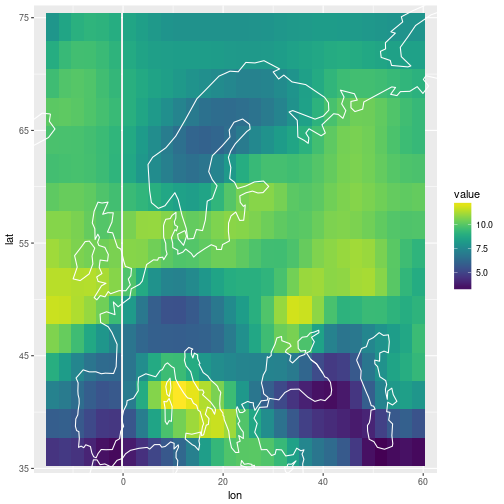
ggplot(df_pred %>% filter(posterior == 'sd')) +
geom_tile(aes(x=lon, y=lat, fill=value)) +
scale_fill_viridis() +
coord_cartesian(xlim=range(storms$lon), ylim=range(storms$lat)) +
geom_path(data=coast, aes(x=long, y=lat, group=group), col='white')
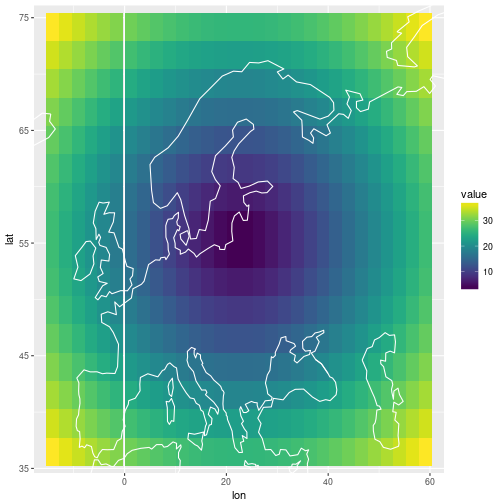
Filling in the missing panel
The posterior predictive mean for the future observation above is on a different scale. Below I produce the same plot as in the beginning, but with the “future obs” panel filled with the posterior predictive mean.
df_ppmean_obs =
inla_data %>%
filter(model == 'obs') %>%
mutate(tden = ifelse(experiment == 'future',
inla_out$summary.fitted.values[pred_row_names, 'mean'],
tden))
ggplot(df_ppmean_obs) +
geom_tile(aes(x=lon, y=lat, fill=tden)) +
facet_wrap( ~ experiment) +
scale_fill_viridis() +
coord_cartesian(xlim = range(storms$lon), ylim=range(storms$lat)) +
geom_path(data=coast, aes(x=long, y=lat, group=group), col='white') +
labs(fill = 'storm\ntrack\ndensity')
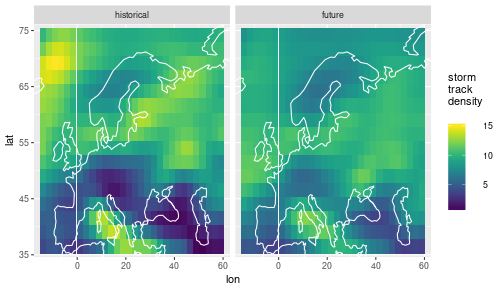
Difference between the posterior predictive mean and the historical observations
df_diff =
df_ppmean_obs %>%
select(lat, lon, experiment, tden) %>%
spread(key=experiment, value=tden) %>%
mutate(diff = future - historical)
ggplot(df_diff) +
geom_tile(aes(x=lon, y=lat, fill=diff)) +
scale_fill_viridis() +
coord_cartesian(xlim = range(storms$lon), ylim=range(storms$lat)) +
geom_path(data=coast, aes(x=long, y=lat, group=group), col='white')
